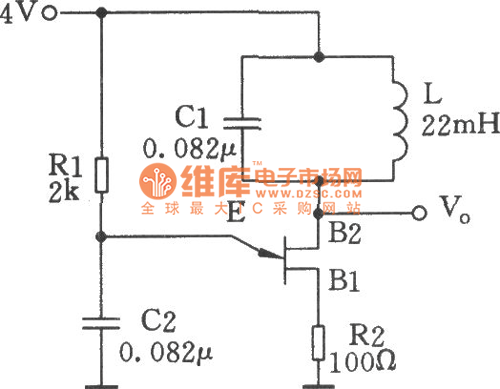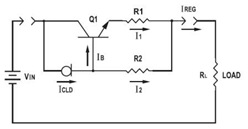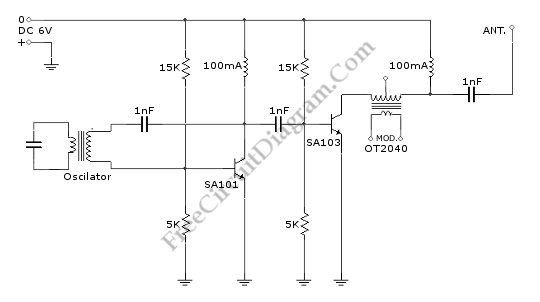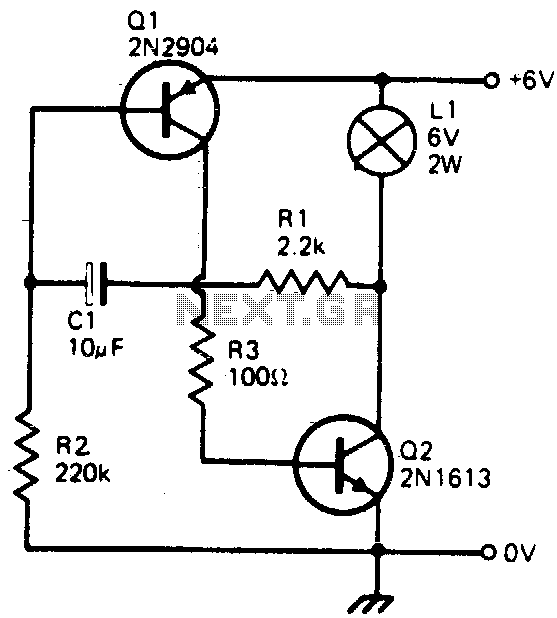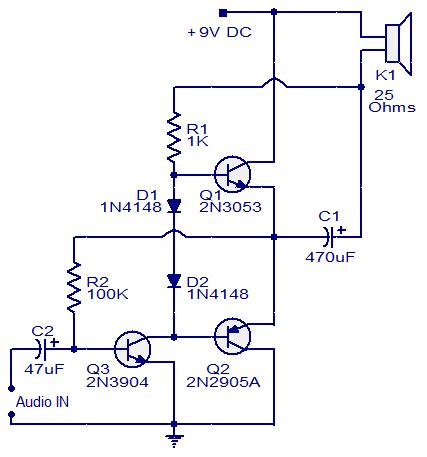
The Transistor Amplifier-P2
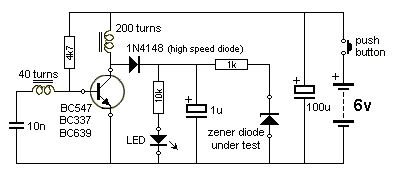
The three circuits described provide a constant current to the LED (or LEDs) when the supply voltage reaches 15V or higher. The second and third circuits can be activated or deactivated through the input line by turning on the top transistor via a 2.2kΩ resistor. The top transistor remains on until the voltage drop across resistor R reaches 0.65V. At this point, the lower transistor begins to turn on, allowing current to flow through the collector-emitter terminals, effectively diverting current from the top transistor. As a result, the top transistor ceases to conduct, and the current through resistor R equals the current flowing through the LEDs, preventing any increase in current. The top transistor is activated through the 2.2kΩ resistor, generating a voltage across resistor R. When this voltage reaches 0.7V, the emitter is 0.7V above the ground rail, and the base is at 1.4V. If the transistor turns on further, the emitter will rise to 0.8V above the ground rail, resulting in only a 0.6V difference between the base and emitter, which is insufficient to keep the transistor on. Thus, the maximum voltage drop across resistor R is limited to 0.65V. Figure 71ba illustrates two additional constant current circuits that source the LEDs. These seven constant current circuits offer the option to either source or sink the LED current. When the circuit is activated, the current through R is zero, and the base voltage of the BC547 fully activates it. The voltage difference between the collector and emitter is approximately 0.2V, which indicates that the emitter of the power transistor is lower than the base of the BC547. The base of the power transistor is 0.7V above the base of the BC547, allowing it to turn on fully. As current increases through R, the voltage across R reaches 0.7V, causing the BC547 to begin turning off. The collector voltage rises, which in turn starts to deactivate the power transistor. This mechanism limits the current through the load based on the value of R. A transistor can function as a "detector" in a radio circuit. The detector stage in a radio (such as an AM receiver) is typically a crystal, but it can also be the base-emitter junction of a transistor. This component detects the audio component of an RF signal, which is then amplified and sent to a speaker. A single transistor can accomplish both detection and amplification. The first two transistors provide significant gain and a high input impedance for the tuned circuit composed of a 60-turn aerial coil and a 415pF tuning capacitor. The signal generated in the tuned circuit is prevented from dissipating by the 10nF capacitor, which maintains a stable left end. The coupling capacitor transfers minimal energy unless it is fully discharged during part of the cycle, which limits its ability to receive energy during the charging phase. This aspect has not been widely discussed in textbooks. The energy flow into the capacitor, driven by the voltage difference between its terminals, creates energy transfer from one stage to another. This concept can be likened to a "magnet on the door" analogy previously mentioned. However, audio circuits operate over a wide frequency range, and the lowest frequency is usually selected, as the capacitor exhibits the highest resistance at this frequency. For example, a 10µF capacitor at 200Hz behaves like a 100Ω resistor between stages, while a 100µF capacitor at the same frequency resembles a 10Ω resistor. Essentially, the resistor transfers a comparable amount of energy as the capacitor while allowing DC voltages to be maintained. Figure 71d illustrates that the "resistance" of a capacitor is significantly lower than the load resistance, which is the primary factor determining the energy transfer.
The described circuits utilize transistors to regulate current flow effectively, ensuring that LEDs receive a consistent current regardless of fluctuations in supply voltage. The interaction between the top and lower transistors, controlled through the resistor R, establishes a feedback mechanism that stabilizes current output. The design is particularly advantageous in LED applications, where consistent brightness is essential.
In radio applications, the dual functionality of transistors as both detectors and amplifiers enhances circuit efficiency, allowing for compact designs that can effectively process audio signals. The tuned circuit's configuration, incorporating a coil and capacitor, enables selective frequency response, which is critical for clear audio reproduction. The careful selection of capacitors based on frequency characteristics ensures optimal energy transfer between circuit stages, while the use of resistors maintains the necessary DC voltage levels. This comprehensive design approach illustrates the intricate balance between various components in electronic circuits, demonstrating their collective role in achieving desired performance outcomes.The three circuits above provide a constant current through the LED (or LEDs) when the supply rises to 15v and higher. The second and third circuits can be turned on and off via the input line. This is done by turning on the top transistor via the 2k2resistor. It keeps turning on until the voltage-drop across resistor R is 0. 65v. At this point the lower transistor starts to turn on and current flows through the collector-emitter terminals and it "robs" the top transistor of current from the 2k2 resistor. The top transistor cannot turn on any more and the current flowing though R is the same as the current flowing through the LEDs and does not increase.
The transistor is turned on via the 2k2 resistor and a voltage is developed across resistor R. When this voltage is 0. 7v, the emitter is 0. 7v above the 0v rail and the base is 1. 4v. If the transistor turns on more, the emitter will be 0. 8v above the 0v rail and this will only give 0. 6v between base and emitter. The transistor would not be turned on with this voltage-drop, so the transistor cannot be turned on any more than 0. 65v across the resistor R. Fig 71ba shows two more constant current circuits "sourcing" the LEDs. The 7 constant current circuits give you the choice of either sourcing or sinking the LED current. When the circuit turns ON, the current through R is zero and the voltage on the base of the BC547 turns it on fully.
The voltage between collector and emitter is about 0. 2v and this means the emitter of the power transistor is below the base of the BC547. The base of the power transistor is 0. 7v above the base of the BC547 and the power transistor also turns on fully. Current increases through R and when the voltage across R reaches 0. 7v, The BC547 starts to turn OFF. The collector voltage rises and this starts to turn OFF the power transistor. This is how the current through the LOAD is limited by the value of R. A transistor can be used as a "detector" in a radio circuit. The Detector stage in a radio (such as an AM receiver), is usually a crystal, but can be the base-emitter junction of a transistor. It detects the slowly rising and falling audio component of an RF signal. This signal is further amplified and delivered to a speaker. A single transistor will perform both "detection" and amplification. The first two transistors provide enormous gain and a very high input impedance for the tuned circuit made up of the 60t aerial coil and 415p tuning capacitor.
The signal generated in the "tuned circuit" is prevented from "disappearing out the left end" by the presence of the 10n capacitor as it holds the left end rigid. We have shown the coupling capacitor transfers very little energy when it does not get fully discharged during part of the cycle and this means it cannot receive a lot of energy to charge it during the "charging" part of the cycle.
This is a point that has never been discussed in any text books. It is the energy (actually the current - due to the difference in voltage between the two terminals of the capacitor) that flows into the capacitor that creates the flow of energy from one stage to the other. It is the "magnet on the door" analogy described previously. But an audio circuit has a wide range of frequencies and the lowest frequency is generally selected as the capacitor will have the highest resistance at the lowest frequency.
A 10u capacitor at 200Hz is like putting a 100R resistor between one stage and the next and a 100u capacitor at 200Hz is like putting a 10R resistor between one stage and the next. In other words, the resistor transfers approximately the same amount of energy as the capacitor but the capacitor separates the DC voltages - the capacitor allows the naturally-occurring voltages to be maintained.
In Fig 71d you can see the "resistance" of a capacitor is very small compared to the LOAD resistance (the main component that determines the amount of energy 🔗 External reference
The described circuits utilize transistors to regulate current flow effectively, ensuring that LEDs receive a consistent current regardless of fluctuations in supply voltage. The interaction between the top and lower transistors, controlled through the resistor R, establishes a feedback mechanism that stabilizes current output. The design is particularly advantageous in LED applications, where consistent brightness is essential.
In radio applications, the dual functionality of transistors as both detectors and amplifiers enhances circuit efficiency, allowing for compact designs that can effectively process audio signals. The tuned circuit's configuration, incorporating a coil and capacitor, enables selective frequency response, which is critical for clear audio reproduction. The careful selection of capacitors based on frequency characteristics ensures optimal energy transfer between circuit stages, while the use of resistors maintains the necessary DC voltage levels. This comprehensive design approach illustrates the intricate balance between various components in electronic circuits, demonstrating their collective role in achieving desired performance outcomes.The three circuits above provide a constant current through the LED (or LEDs) when the supply rises to 15v and higher. The second and third circuits can be turned on and off via the input line. This is done by turning on the top transistor via the 2k2resistor. It keeps turning on until the voltage-drop across resistor R is 0. 65v. At this point the lower transistor starts to turn on and current flows through the collector-emitter terminals and it "robs" the top transistor of current from the 2k2 resistor. The top transistor cannot turn on any more and the current flowing though R is the same as the current flowing through the LEDs and does not increase.
The transistor is turned on via the 2k2 resistor and a voltage is developed across resistor R. When this voltage is 0. 7v, the emitter is 0. 7v above the 0v rail and the base is 1. 4v. If the transistor turns on more, the emitter will be 0. 8v above the 0v rail and this will only give 0. 6v between base and emitter. The transistor would not be turned on with this voltage-drop, so the transistor cannot be turned on any more than 0. 65v across the resistor R. Fig 71ba shows two more constant current circuits "sourcing" the LEDs. The 7 constant current circuits give you the choice of either sourcing or sinking the LED current. When the circuit turns ON, the current through R is zero and the voltage on the base of the BC547 turns it on fully.
The voltage between collector and emitter is about 0. 2v and this means the emitter of the power transistor is below the base of the BC547. The base of the power transistor is 0. 7v above the base of the BC547 and the power transistor also turns on fully. Current increases through R and when the voltage across R reaches 0. 7v, The BC547 starts to turn OFF. The collector voltage rises and this starts to turn OFF the power transistor. This is how the current through the LOAD is limited by the value of R. A transistor can be used as a "detector" in a radio circuit. The Detector stage in a radio (such as an AM receiver), is usually a crystal, but can be the base-emitter junction of a transistor. It detects the slowly rising and falling audio component of an RF signal. This signal is further amplified and delivered to a speaker. A single transistor will perform both "detection" and amplification. The first two transistors provide enormous gain and a very high input impedance for the tuned circuit made up of the 60t aerial coil and 415p tuning capacitor.
The signal generated in the "tuned circuit" is prevented from "disappearing out the left end" by the presence of the 10n capacitor as it holds the left end rigid. We have shown the coupling capacitor transfers very little energy when it does not get fully discharged during part of the cycle and this means it cannot receive a lot of energy to charge it during the "charging" part of the cycle.
This is a point that has never been discussed in any text books. It is the energy (actually the current - due to the difference in voltage between the two terminals of the capacitor) that flows into the capacitor that creates the flow of energy from one stage to the other. It is the "magnet on the door" analogy described previously. But an audio circuit has a wide range of frequencies and the lowest frequency is generally selected as the capacitor will have the highest resistance at the lowest frequency.
A 10u capacitor at 200Hz is like putting a 100R resistor between one stage and the next and a 100u capacitor at 200Hz is like putting a 10R resistor between one stage and the next. In other words, the resistor transfers approximately the same amount of energy as the capacitor but the capacitor separates the DC voltages - the capacitor allows the naturally-occurring voltages to be maintained.
In Fig 71d you can see the "resistance" of a capacitor is very small compared to the LOAD resistance (the main component that determines the amount of energy 🔗 External reference
